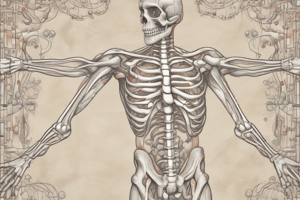Podcast
Questions and Answers
What is the primary mechanism by which neuromuscular blocking agents (NMBAs) cause muscle weakness or paralysis?
What is the primary mechanism by which neuromuscular blocking agents (NMBAs) cause muscle weakness or paralysis?
- Increasing the release of acetylcholine at the neuromuscular junction, leading to receptor overstimulation and desensitization.
- Increasing the breakdown of acetylcholine in the synaptic cleft, reducing its ability to bind to receptors.
- Interfering with the transmission of nerve conduction in skeletal muscle. (correct)
- Directly damaging muscle fibers, preventing them from contracting.
Which of the following is a common clinical application of neuromuscular blocking agents (NMBAs)?
Which of the following is a common clinical application of neuromuscular blocking agents (NMBAs)?
- Treatment of chronic pain syndromes.
- Management of anxiety disorders.
- Lowering body temperature in febrile patients.
- Facilitation of procedures and studies. (correct)
What physiological event occurs immediately after depolarization at the neuromuscular junction?
What physiological event occurs immediately after depolarization at the neuromuscular junction?
- Acetylcholine is broken down by acetylcholinesterase.
- An action potential is generated in the muscle cell. (correct)
- The neuron repolarizes, restoring the resting membrane potential.
- Calcium ions are released from the sarcoplasmic reticulum.
What is the role of acetylcholinesterase (AChE) in the physiology of the neuromuscular junction?
What is the role of acetylcholinesterase (AChE) in the physiology of the neuromuscular junction?
How do nondepolarizing neuromuscular blocking agents primarily block muscle contraction?
How do nondepolarizing neuromuscular blocking agents primarily block muscle contraction?
Nondepolarizing neuromuscular blocking agents are administered via which route?
Nondepolarizing neuromuscular blocking agents are administered via which route?
What is a characteristic of the metabolism of d-Tubocurarine and doxacurium?
What is a characteristic of the metabolism of d-Tubocurarine and doxacurium?
Which of the following represents a significant adverse cardiovascular effect associated with the use of certain nondepolarizing neuromuscular blocking agents?
Which of the following represents a significant adverse cardiovascular effect associated with the use of certain nondepolarizing neuromuscular blocking agents?
How do acetylcholinesterase inhibitors reverse the effects of nondepolarizing neuromuscular blocking agents?
How do acetylcholinesterase inhibitors reverse the effects of nondepolarizing neuromuscular blocking agents?
How does succinylcholine cause muscle paralysis?
How does succinylcholine cause muscle paralysis?
What is a key characteristic of depolarizing neuromuscular blocking agents like succinylcholine?
What is a key characteristic of depolarizing neuromuscular blocking agents like succinylcholine?
What is a potential adverse effect associated with the use of succinylcholine?
What is a potential adverse effect associated with the use of succinylcholine?
In patients with abnormal or deficient pseudocholinesterase, how is the duration of action of succinylcholine affected?
In patients with abnormal or deficient pseudocholinesterase, how is the duration of action of succinylcholine affected?
In which clinical scenario are neuromuscular blocking agents (NMBAs) considered beneficial in the context of mechanical ventilation?
In which clinical scenario are neuromuscular blocking agents (NMBAs) considered beneficial in the context of mechanical ventilation?
What precautions should be taken when NMBAs are used in conjunction with mechanical ventilation?
What precautions should be taken when NMBAs are used in conjunction with mechanical ventilation?
What is the primary reason for administering sedatives and analgesics in conjunction with neuromuscular blocking agents (NMBAs)?
What is the primary reason for administering sedatives and analgesics in conjunction with neuromuscular blocking agents (NMBAs)?
Which of the following is an example of a medication that could potentiate the blockade induced by neuromuscular blocking agents?
Which of the following is an example of a medication that could potentiate the blockade induced by neuromuscular blocking agents?
Which of the following factors should be considered when choosing a neuromuscular blocking agent (NMBA) for a patient?
Which of the following factors should be considered when choosing a neuromuscular blocking agent (NMBA) for a patient?
Why is it important to rule out ventilator malfunction as the cause of agitation before initiating NMBA?
Why is it important to rule out ventilator malfunction as the cause of agitation before initiating NMBA?
During the monitoring of neuromuscular blockade, what is the typical order of muscle activity loss?
During the monitoring of neuromuscular blockade, what is the typical order of muscle activity loss?
During train-of-four monitoring, what does the presence of 2 twitches indicate?
During train-of-four monitoring, what does the presence of 2 twitches indicate?
How does sugammadex reverse the effects of rocuronium and vecuronium?
How does sugammadex reverse the effects of rocuronium and vecuronium?
A patient receiving mechanical ventilation develops agitation. After ruling out ventilator malfunction, which of the following should be prioritized?
A patient receiving mechanical ventilation develops agitation. After ruling out ventilator malfunction, which of the following should be prioritized?
A patient is receiving a nondepolarizing NMBA. Upon assessing the patient, the nurse notes the presence of 4 twitches. What would this indicate?
A patient is receiving a nondepolarizing NMBA. Upon assessing the patient, the nurse notes the presence of 4 twitches. What would this indicate?
A patient with renal failure requires neuromuscular blockade. Which nondepolarizing agent would be the MOST appropriate?
A patient with renal failure requires neuromuscular blockade. Which nondepolarizing agent would be the MOST appropriate?
A patient is given succinylcholine to facilitate intubation. After the procedure, the patient experiences prolonged paralysis despite normal renal and hepatic function. Which condition is MOST likely?
A patient is given succinylcholine to facilitate intubation. After the procedure, the patient experiences prolonged paralysis despite normal renal and hepatic function. Which condition is MOST likely?
Which agent has the greatest potential to cause cardiovascular side effects?
Which agent has the greatest potential to cause cardiovascular side effects?
A patient receiving mechanical ventilation and neuromuscular blockade is at risk for aspiration. Which intervention is MOST important?
A patient receiving mechanical ventilation and neuromuscular blockade is at risk for aspiration. Which intervention is MOST important?
A patient is being treated for status epilepticus. To help terminate it, they are given NMBA. What is a NMBA that can be used to help terminate status epilepticus?
A patient is being treated for status epilepticus. To help terminate it, they are given NMBA. What is a NMBA that can be used to help terminate status epilepticus?
A patient receiving mechanical ventilation in the ICU is started on a continuous infusion of a neuromuscular blocking agent. After 48 hours, the patient's family expresses concern that the patient's eyes are not being cared for. Which of the following is the BEST intervention to address this concern?
A patient receiving mechanical ventilation in the ICU is started on a continuous infusion of a neuromuscular blocking agent. After 48 hours, the patient's family expresses concern that the patient's eyes are not being cared for. Which of the following is the BEST intervention to address this concern?
Which is a primary difference between depolarizing and non-depolarizing agents?
Which is a primary difference between depolarizing and non-depolarizing agents?
Which best describes how loss of muscle activity occurs as a result of NMBA?
Which best describes how loss of muscle activity occurs as a result of NMBA?
What is the function of Gantacurium?
What is the function of Gantacurium?
Flashcards
Neuromuscular Blocking Agents (NMBAs)
Neuromuscular Blocking Agents (NMBAs)
Drugs causing skeletal muscle weakness or paralysis, administered IV with dose-related muscle response.
Uses of NMBAs
Uses of NMBAs
NMBAs facilitate intubation, aid surgery, enhance ventilator synchrony, reduce ICP and O2 consumption.
CNS
CNS
The division of the nervous system containing the brain and spinal cord.
PNS Function
PNS Function
Coordinates the body's functions via voluntary and involuntary control.
Signup and view all the flashcards
Acetylcholine’s Role
Acetylcholine’s Role
Primary neurotransmitter mediating nerve conduction in skeletal muscle. Broken down by acetylcholinesterase (AChE).
Signup and view all the flashcards
Depolarization
Depolarization
Occurs when an action potential is triggered.
Signup and view all the flashcards
Repolarization
Repolarization
Membrane potential returns to baseline.
Signup and view all the flashcards
NMBAs Mechanism
NMBAs Mechanism
Block muscle contraction through competitive inhibition or prolonged occupation.
Signup and view all the flashcards
Nondepolarizing Agents Function
Nondepolarizing Agents Function
Nondepolarizing agents compete with acetylcholine, blocking receptors without activating them.
Signup and view all the flashcards
Acetylcholinesterase inhibitors
Acetylcholinesterase inhibitors
Inhibitors like neostigmine reverse blockade by increasing acetylcholine availability
Signup and view all the flashcards
Nondepolarizing Pharmacokinetics
Nondepolarizing Pharmacokinetics
Chemically related to acetylcholine, they are poorly lipophilic and must be given IV.
Signup and view all the flashcards
Metabolism of Nondepolarizing Agents
Metabolism of Nondepolarizing Agents
dTC and doxacurium are minimally metabolized; pancuronium has some hepatic metabolism.
Signup and view all the flashcards
Atracurium/cisatracurium
Atracurium/cisatracurium
Atracurium/cisatracurium are optimal for hepatic/renal failure as they undergo Hofmann degradation; mivacurium is shortest acting
Signup and view all the flashcards
Nondepolarizing Hazards
Nondepolarizing Hazards
Cardiovascular and histaminic effects, inadequate ventilation.
Signup and view all the flashcards
Vagolytic Effect
Vagolytic Effect
May result in tachycardia and increased mean arterial pressure.
Signup and view all the flashcards
Histamine Release Effects
Histamine Release Effects
Histamine release yields hypotension, reflex tachycardia, and bronchospasm.
Signup and view all the flashcards
Agents to Reverse Blockade
Agents to Reverse Blockade
Neostigmine, Edrophonium or Pyridostigmine
Signup and view all the flashcards
Depolarizing Agents
Depolarizing Agents
Shorter acting; no reversal agents exist; succinylcholine is the only agent.
Signup and view all the flashcards
Succinylcholine Metabolism
Succinylcholine Metabolism
Rapid metabolism by plasma cholinesterase makes its effects very short in duration.
Signup and view all the flashcards
Depolarizing Agents Action
Depolarizing Agents Action
Depolarizes muscle membrane like acetylcholine; Phase I – flaccid paralysis. Phase II – resembles non-depolarization.
Signup and view all the flashcards
Reversal of succinylcholine
Reversal of succinylcholine
No agent available for reversal of succinylcholine
Signup and view all the flashcards
Effects of Depolarizing Agents
Effects of Depolarizing Agents
Includes sympathomimetic and vagal responses, muscle pain, and malignant hyperthermia.
Signup and view all the flashcards
Succinylcholine
Succinylcholine
Genetic sensitivity, deficiency in pseudocholinesterase
Signup and view all the flashcards
NMBA Use
NMBA Use
Treats ARDS, status asthmaticus/epilepticus neuromuscular toxins, and tetanus.
Signup and view all the flashcards
NMBA and Ventilation Precautions
NMBA and Ventilation Precautions
Proper eye care, suctioning, sedation/analgesia, prevent aspiration and pneumonia, minimize weakness/ulcers/DVT.
Signup and view all the flashcards
Sedation with NMBAs
Sedation with NMBAs
Absolutely essential due to paralysis, monitor for autonomic signs; use analgesics and amnestics.
Signup and view all the flashcards
NMBA Interactions
NMBA Interactions
Inhaled anesthetics, aminoglycosides, potentiate, phenytoin, azathioprine and theophylline antagonize.
Signup and view all the flashcards
Choosing NMBAs
Choosing NMBAs
NMBA choice depends on the situation, duration, intubation need, effects elimination and cost.
Signup and view all the flashcards
Monitoring Blockade
Monitoring Blockade
Assess patient agitation, rule out ventilator problems, use visual tactile, or electronic methods.
Signup and view all the flashcards
Twitch
Twitch
Monitors muscle contractions to evaluate NMBA effect. Zero is 100% blockade
Signup and view all the flashcards
Evaluation of NMBAs
Evaluation of NMBAs
2 HZ with 0 twitches - 100% blocked
Signup and view all the flashcards
Gantacurium
Gantacurium
Organ independent and less histamine release
Signup and view all the flashcards
Sugammadex
Sugammadex
Inactivates NMBA. Effective with pancuronium and succinylcholine
Signup and view all the flashcardsStudy Notes
- Skeletal Muscle Relaxants are also known as Neuromuscular Blocking Agents (NMBAs).
- NMBAs are drugs which cause skeletal muscle weakness or paralysis.
- NMBAs can be either nondepolarizing or depolarizing agents.
- Administered intravenously, NMBAs elicit a response in muscles that is dose-related.
Uses of NMBAs
- NMBAs aid intubation and can be used during surgery.
- These agents enhance ventilator synchrony, and reduce intracranial pressure (ICP).
- NMBAs reduce O2 consumption and terminate status epilepticus and tetanus.
- These relaxants facilitate medical procedures/studies and keep patients immobile.
Physiology of the Neuromuscular Junction
- The CNS consists of the brain and spinal cord.
- The PNS includes the somatic motor nervous system which controls skeletal muscles via voluntary control.
- The PNS also consists of the autonomic nervous system which regulates involuntary control.
Neuron and Neurotransmitter
- A neuron consists of a cell body, axons, and dendrites.
- Transmission of nerve conduction in skeletal muscle is chemically mediated by acetylcholine.
- Acetylcholine is broken down by acetylcholinesterase (AChE).
Depolarization and Repolarization
- Depolarization causes an action potential to occur.
- During Repolarization the membrane potential returns to baseline.
Blocking Muscle Contraction
- Muscle contraction can be blocked in two ways
- The first is competitive inhibition, using nondepolarizing agents
- The second is prolonged occupation and persistent binding, using depolarizing agents
Nondepolarizing Agents
- Nondepolarizing Agents cause competitive inhibition.
- Nondepolarizing Agents block acetylcholine receptors without activating them.
Mode of Action
- Nondepolarizing agents affect postsynaptic cholinergic receptors at the neuromuscular junction.
- These compete against endogenous acetylcholine and the effect is dose related.
- Acetylcholinesterase inhibitors like Neostigmine can reverse blockade.
- Nondepolarizers occupy but do not activate acetylcholine receptors, preventing acetylcholine from occupying receptors and causing muscle contraction to fail.
- Released acetylcholine is rapidly metabolized by membrane cholinesterase.
- Nondepolarizers also bind to prejunctional acetylcholine receptors and modify acetylcholine release.
Pharmacokinetics of Nondepolarizing Agents
- Nondepolarizing agents chemically resemble acetylcholine but are poorly lipophilic.
- They are poorly absorbed in the GI tract, requiring IV administration.
- Paralysis onset and action duration vary widely and depend on the dosage.
- Nondepolarizing agents last longer than depolarizing agents.
- Their duration can be prolonged by advanced age, and hepatic or renal failure.
Metabolism of Nondepolarizing Agents
- When normal conduction returns, 75% of receptors might still be occupied by a blocker, additional boluses may seem more potent.
- d-Tubocurarine and doxacurium are minimally metabolized, with 60% excreted by the kidneys and the remainder in bile
- Pancuronium undergoes some hepatic metabolism.
- Atracurium and cisatracurium are partly inactivated by spontaneous degradation by pH and temperature called Hofmann degradation, and are ideal for patients with hepatic or renal failure.
- Vecuronium undergoes primary hepatic metabolism.
- Mivacurium is one of the shortest acting, lasting 10–20 minutes, and is eliminated by plasma cholinesterase.
Adverse Effects and Hazards
- Cardiovascular effects potentially include a vagolytic effect, leading to tachycardia and increased mean arterial pressure.
- Pancuronium poses the greatest risk for cardiovascular side effects.
- Histamine release can cause hypotension, reflex tachycardia, and bronchospasm upon release from mast cells.
- These agents can cause Inadequate ventilation potentially leading to paralysis of the diaphragm and intercostals.
Reversal of Nondepolarizing Blockade
- Reversal can be achieved using an indirect-acting agent.
- Cholinesterase inhibitors can be used to produce the desired effect, inhibiting cholinesterase, breaking down acetylcholine
- Allows more acetylcholine at the junction to displace the blocker.
- Examples of agents include neostigmine, edrophonium, and pyridostigmine.
Depolarizing Agents
- Depolarizing agents are shorter acting than nondepolarizing agents.
- No agents can reverse the effects of Depolarizing Agents.
- The only available agent is succinylcholine.
- Paralysis occurs in 60–90 seconds and lasts 10-15 minutes.
- Depolarizing Agents are ideal for patients who require intubation.
- Succinylcholine produces a depolarizing block by occupying and activating acetylcholine receptors.
- The process lets sodium enter and create an initial action potential.
- Continued occupancy stops repolarization and the next action potential from released acetylcholine.
- Activation of prejunctional acetylcholine receptors can modify how acetylcholine is released.
Mode of Action
- Depolarizing agents act by depolarizing the muscle membrane like acetylcholine.
- These agents are resistant to AchE for a longer period of time.
- They cause fasciculations.
- A Phase I block causes prolonged depolarization/flaccid paralysis.
- A Phase II block resembles nondepolarizing block and limits use in repeat doses.
Metabolism and Reversal
- Depolarizing agents undergo rapid hydrolysis by plasma cholinesterase.
- There are no agents available for reversal of succinylcholine.
Adverse Effects and Hazards
- Sympathomimetic response.
- Vagal response with repeat boluses is more often seen in children.
- These agents can cause muscle pain/soreness, histamine release, and hyperkalemia.
- Depolarizing Agents can cause increased intracranial, intraoptic, and intragastric pressure.
- Malignant hyperthermia is also a potential hazard.
Sensitivity to Succinylcholine
- Succinylcholine is metabolized by plasma cholinesterase (pseudocholinesterase).
- Patients with abnormal or deficient pseudocholinesterase will not metabolize succinylcholine effectively.
- This leads to prolonged recovery time and prolonged mechanical ventilation support.
NMBAs and Mechanical Ventilation
- NMBAs help improve ventilation and oxygenation, and reduce pressure.
- Beneficial in treating acute respiratory distress syndrome (ARDS) and status asthmaticus.
- Beneficial in inverse ratio ventilation and high-frequency oscillatory ventilation (HFOV).
- NMBAs can also benefit those with Status epilepticus, Neuromuscular toxins and Tetanus
Precautions and Risks
- Proper eye care and Suctioning
- Ensure Proper sedation and analgesia.
- These Agents can lead to Aspiration/nosocomial pneumonia and risk of prolonged skeletal muscle weakness.
- NMBAs can cause Decubitus ulcers and Deep venous thrombosis (DVT).
Use of Sedation and Analgesia
- Using Sedation and analgesia is absolutely essential!
- Key to monitor for tachycardia, hypertension, diaphoresis, and lacrimation.
- Analgesics include Fentanyl and Morphine
- Amnestic sedatives include Propofol, Lorazepam, and Midazolam.
Interactions with Neuromuscular Blocking Agents
- Inhaled anesthetics potentiate blockade, as do aminoglycosides.
- Agents antagonizing NMBA include Phenytoin, Azathioprine, and Theophylline.
- Blockade is Potentiated by Acidosis, Hypokalemia, Hyponatremia, Hypocalcemia, and Hypomagnesemia.
Choice of Agents
- The choice of agent is situation dependent.
- Factors to consider can include; the duration of procedure, need for quick intubation, adverse effects, route of elimination, drug interactions, and cost.
Monitoring Neuromuscular Blockade
- Paralysis may mask clinical signs/symptoms.
- Rule out Ventilator malfunction first as the cause of agitation before initiating NMBA.
- Include visual, tactile, and electronic methods.
Loss and Return of Muscle Activity
- Loss of muscle activity happens in this order; Eyelids, Face, Neck, Extremities, Abdomen, Intercostals, and Diaphragm.
- Return of muscle activity occurs in the reverse order.
Twitch Monitoring and Train-of-Four Evaluation
- 2 Hz over 2 seconds is the standard.
- 0 twitches = 100% blockade.
- 1 twitch = 95% blockade.
- 2 twitches = 90% blockade.
- 3 twitches = 80% blockade.
- 4 twitches = <75% blockade.
Studying That Suits You
Use AI to generate personalized quizzes and flashcards to suit your learning preferences.




